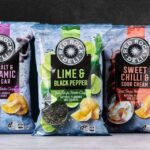The bar code or barcode technology has gained wide acceptance in numerous applications, including food packaging. The main advantages of barcode in food packaging are speed and accuracy. Tanweer Alam* explains here the applications of barcode in food packaging.
Table of Contents: Barcode in Food Packaging
Barcode technology has been used for decades. Although the first major implementation thrust occurred in the retail food industry, nearly all other sectors enjoy substantial benefits. Barcoding is a system developed to assign a unique number to any packaged product or service in existence, produced, or produced. This system is designed to identify the product during handling and transportation. The purpose of a barcode is to represent information in a machine-readable form.
A barcode or bar code is defined as a series of bars and spaces arranged according to the encodation rules of a particular specification to represent data. The successful use of barcoding involves many different ingredients. The primary objective of the key points of Bar Coding is to summarize the various factors into simple, understandable terms. If this foundation is understood and used properly, successful implementation is highly probable. These vital tips are based on real-world experiences and primarily focus on Code 39, Code 128, and U.P.C./EAN linear symbologies. However, these fundamentals are applied to other linear, two-dimensional, and matrix codes.

Who Invented Barcode Technology
In 1949, N.J. Woodward filed a patent for a series of circular symbols. These symbols were to be placed on every item in a retail supermarket to improve productivity and automate the checkout process. The industrial use of barcodes can be traced back as far as the 1960s. Some of these early implementations were used to identify railroad cars. In 1968, Identicon Corporation created the 2 of 5 barcode symbology for warehouse inventory and cargo handling. The name comes from the five bars per character, two of which are wide. Due to its low density, 2 of 5 caused problems for manufacturers of barcode printers.
Common barcodes started appearing on grocery shelves in the early 1970s as the UPC code, to automate identifying grocery items. In 1972, an interleaved variation created by Interface Mechanisms (Intermec), resolved this issue by combining two values into the same five bars, using the four spaces in between. This interleaving technique meant that a barcode could double the information in the same space.
By 1981, Interleaved 2 of 5 became the accepted symbology for UPC retail multipack containers. The UCC developed the SCC-14 standard, in which the supplier uses the same data from its UPC product labels and adds a packaging indicator to designate cartons. The result was the UPC (Universal Product Code), a 12-digit number unique to each product. From that initial meeting, an organisation was created to standardise and implement the new concept.
The organization later became the UCC (Uniform Code Council) and now oversees the labelling standards for more than 200,000 member companies. Four years after implementing the UPC, the EAN (European Article Numbering) system was created internationally. Derived from the UPC, the EAN-13 is one digit longer to accommodate country codes.
Why Use Barcode in Food Packaging?
The main advantages of barcodes in food packaging are speed and accuracy. The barcode can be done in a fraction of a second compared to a manual key entry, capturing data automatically by reading. Generally, the error rate is extremely low, with the order of one error per 10 lakhs readings (Joshi, 1995). In big shopping malls, selling thousands of different sources of supply and packed food worldwide, it is possible to monitor the stock levels of each item available for sale at any moment at the press of a button. It helps to keep the minimum inventory without running the risk of the stock.
Advantages of barcode to manufacturers:
- Updating the stock position
- Easy availability of sales information to a particular lot
- Accurate & fast assessment of the product acceptance/ failure
- Control tool for internal operations
- Inventory & warehouse management etc
- Requirement for export
- Market survey – products sold and rate.
Advantages of barcode to Retailers:
- Instant and better inventory control.
- Easy to monitor the stock out position
- Computer-aided checkout.
- Self-service.
- Avoidance of over and undercharging.
Advantages of barcode to Consumers:
- Minimizing human error
- Right product and pricing

Applications of Barcode in Food Packaging
The barcode technology has gained wide acceptance in numerous applications, including food packaging. Today, virtually all packages and packed food items from the ultimate consumer to the biggest transport units bear one or several codes, carrying their identification number and other data relevant to agencies of shipping, carrying, and receiving goods.
Barcoding plays a vital role in ensuring quality assurance in the food industry, contributing to safety, traceability, and inventory efficiency.
Scanning at the retail point of sale is a major application relying on the EAN/UPC identification number and the associated barcode symbol. Scanning at the point of sale enables automatic registration of sales through price-lookup files. Further extensions include inventory management, automatic re-ordering, and sales analyses.
Barcode technology is also applied to the supply chain of packaged food that is ready for shipment. Foods are packed, and each package is numbered and barcoded with a unique number. When processed by the receiver, the original message is matched, allowing the receiver to verify what has been ordered and delivered. Inventories can then be updated automatically. A barcode labelling standard helps monitor inventory, assists replenishment, minimises distribution time, and allows product traceability. Efficient food distribution and traceability increasingly rely on such digitized systems.
The supplier’s initial time and expense appear justified only in maintaining a business relationship with a customer requiring a label. With time, the increased accuracy, improved order picking, and streamlined inventory evidenced that a barcode labeling system benefits customers and manufacturers alike. The bottom line is to get the right product at the right place in the shortest possible time.
Types of barcode and Uses
The type of barcode to use for a particular situation depends upon:
- the data you need to encode in the barcode; and
- the implementation;
- how you wish to print the barcode.
There are several different types of barcode standards for other purposes – these are called symbologies. Every kind of symbology (or barcode type) is a standard that defines the printed symbol and how a device, such as a barcode scanner, reads and decodes the printed symbol. Industry standards are usually established when multiple parties or companies are involved in the ID process.
There is a difference between standard and barcode symbology. Barcode standards define how to use the barcode symbology in a particular situation. For example, ISBN is a standard for labeling books and periodicals that uses the EAN-13 symbology.
Below, we list a few established barcode standards and what they are used for:
Symbology of Barcode
Barcode technology is central to traceability in modern food supply chains, especially as digitisation grows.
The symbology of barcode is a set of rules discussing how bars and spaces have to be organized to encode data characters. Only a few are being used on a large scale. First, obtaining a company code (unique for every organisation in the country) from the national numbering organisation (NNO) is necessary. The NNO, in turn, obtains its agency, such as the International Article Numbering Association (EAN). While the NNO (only one for each country) has a unique 2 or 3-digit code, it allocates another 4 or 5-digit code to each of its member organisations.
In turn, allocates 5-digit number to each of its products or services. Thus, there are total 12-digits that make a barcode, but there is one more additional digit called a check digit, which completes a barcode number for a given product. This numbering system is under EAN 13 digit code. There is another EAN 8 digit code. The EAN barcodes are acceptable internationally and are compatible with most of the equipment used for scanning and information processing (Anon, 2000).
European Article Numbering (EAN)
EAN/UPC: European Article Numbering (EAN) system and Universal Product Code (UPC) system is a continuous symbology encoding fixed-length number digits. Several variants exist, such as EAN-8, EAN-13, UPC-A, and UPC-E. In addition, the symbology enables to encode 2 small symbols encoding 2 and 5 digits. These are called add-ons. These are especially relevant to retail-driven FMCG distribution networks.
A symbol character is composed of 7 modules, 2 bars, and 2 spaces in the system. A bar or a space is composed of 1 to 4 modules. An EAN/UPC symbol begins and ends with a guard pattern. In EAN-8 and 13 and the UPC-A version, a centre pattern separates the symbol into segments that can be read separately, thereby making the symbol read omnidirectionally. The EAN/UPC symbology is widely used to encode the identification number of consumer products.
Code 128
Code 128 was developed to address the need for a compact alphanumeric code symbol that could be used to encode complex data, capable of being printed by existing data processing printers. Code 128 fulfills the need with the most compact, complete alphanumeric symbology available. In addition, code 128 has been designed with geometric features to improve scanner-reading performance and self-chickening.
Interleaved two of five (ITF)
Interleaved two of five (ITF) is well adapted to materials and printing conditions frequently used on fibreboard cases. It is a continuous symbology encoding only numeric digits. A pair of digits is represented by 5 bars and 5 spaces. One of the pairs is represented by the dark bars and the other by the light bars. These two are interleaved. In addition to the digit characters, there are 2 auxiliary characters used as guard bars at the beginning and the end of the digit representation.
Barcode Printing
Barcode labels can be produced in-house or can be obtained from a barcode label supplier. Barcodes can also be printed on the wrappers, cartons, and other packages with the help of a film master. The film master is negative with a barcode symbol required by the printer to incorporate on the printing plate as part of the total label design or graphic on the package. There are norms prescribed regarding the operation of the barcode system, including the size of the barcode to be used on different food packages, colour combination, and other requirements (Barker, 1995).
For food packaging, sustainable printing and labelling trends are also emerging in tandem with digital requirements.
Following Parameters/ Properties must be strictly defined by Specification on Barcode
- Width and height of the bars
- Size of vertical and horizontal ‘quiet zone’ (amount of blank space left around actual barcode to ensure reliable scanning);
- Text and font settings for human-readable representation of barcode data (text string printed under the bars)
- Barcodes are simple to represent – black rectangles separated by white spaces printed output is the sharpest possible since it is a vector graphics
- Reduced size image
- Every aspect of barcode pattern can be controlled – stroke widths, colors, lengths, etc.
Which technology is used in barcode reader or barcode scanner?
A typical Barcode Reader kit consists of a Scanner, Decoder, and Cable, which interfaces with the computer’s decoder. The scanner scans the Barcode symbol, captures the barcode bars and spaces, and sends it to the decoder. The decoder translates the bars and spaces into corresponding electrical output and transmits that data to the computer in a traditional data format. For instance, automation and AI in food processing are now integral with advanced barcode systems.
A barcode scanner can either have the decoder built into it or be “undecided.” An undecoded barcode scanner requires a separate box called an interface or keyboard wedge.
Computers cannot read barcodes. For a computer to use the information contained in the barcode, the barcode data must be captured and decoded into a data format that the computer can process. The device that reads or captures the barcode information from the food packet and sends it to the decoder is known as the barcode reader, generally called a barcode scanner. Currently, the four different types of barcode readers available are pen-type readers (barcode wands), laser barcode scanners, CCD (Charge-Coupled Device), and camera-based barcode readers. Each type uses a slightly different technology for reading and decoding a barcode (Harmon, 1994).
Pen Type Readers or Barcode Wands
Pen type barcode readers have a light source and a photodiode placed next to each other at the tip of a pen or wand. To read a barcode, you drag the tip of the pen across all the bars in an even steady motion. The photodiode measures the intensity of the light reflected from the light source and generates a waveform corresponding to the widths of the bars and spaces in the barcode. The barcode reader sends the waveform to the decoder, which decodes the waveform and sends it to the computer in a traditional data format.
Laser Barcode Scanners
Laser barcode scanners work the same way as pen-type barcode readers. The only main difference is that Laser barcode scanners use a laser beam as their light source and typically employ either a reciprocating mirror or a rotating prism to scan the laser beam back and forth across the barcode. As with the pen-type barcode reader, a photodiode is used to measure the intensity of the light reflected from the barcode.
CCD Barcode Scanners
CCD barcode scanners use an array of tiny light sensors lined up in a row in the head of the barcode reader. Voltage waveform corresponding to the bars and spaces of the barcode is generated and sent to the decoder, which decodes the data and sends it to the computer. The main difference between a CCD barcode scanner, a pen-type barcode scanner, and a laser barcode scanner is that the CCD barcode scanner measures emitted ambient light from the barcode. In contrast, pen or laser barcode scanners measure reflected light of a specific frequency originating from the scanner itself.
Camera-Based Barcode Readers
The camera-based barcode readers use a small video camera to capture an image of a barcode. The barcode reader then uses sophisticated digital image processing techniques to decode the barcode.
Connection of Barcode Scanner to Computer
Barcode readers come in either “keyboard wedge” output or RS232 output. A barcode reader with keyboard wedge output plugs directly into the keyboard port to the computer and also provides a pigtail connector to plug the keyboard simultaneously. When a barcode is scanned with the keyboard wedge barcode reader, the barcode data goes into the computer as if it were typed in on the keyboard. It is advantageous because the keyboard wedges are simple and easy to interface to the computer. No software is required.
Barcode Reader with RS232 or “Serial Interface”
This type of barcode reader is connected to an available serial port on the back of your computer. During barcode reading, it must be controlled over where data goes.
Microprocessing During Reading of Barcode in Food Packaging
Standardisation ensures that barcodes are accurately readable by any scanner, ensuring seamless inventory management and food safety. Microprocessors convert reflectance patterns into binary data, later decoded into product-specific information.
Many types of devices are available to read barcodes. However, it is necessary to bring in standardization of barcodes to make it readable by common scanners and processing equipment used and to ensure correct reading of the barcode at first instance every time by the scanner. They all illuminate the symbol and analyse the resulting reflectance. High-reflectance areas are interpreted as spaces, while areas of low reflectance are represented as bars. The decoder assigns binary values to the signal and forms a complete message.
It is checked by the decoder and transformed into data. Fixed-beam readers depend on an external motion to read the symbol. A popular reading device is the low-cost hand-held contact scanner. Moving-beam readers use a mirrored moving surface to provide illumination. The light source appears as a continuous line of light. The moving beam reader is also called a laser scanner. Imaging devices (cameras) are also used to read barcodes. The reflected image of the barcode is projected onto photodiodes composed of many photo-detectors. These, in turn, are sampled by microprocessors and produce a video signal that is then decoded.
What is the future of barcodes?
Only a few organizations in the country currently provide barcode labels, printers, scanners, and other accessories from the imported kit. Though the trade and food industry appreciates the importance of the barcode system, the system has yet to be followed wholeheartedly in all Indian food package products. Now, it is concluded that a barcode is just a different way of encoding numbers and letters, using a combination of bars and spaces of varying widths. It is just another way of entering data into a computer.
A barcode does not contain descriptive data. It is a reference number that a computer uses to look up an associated record that contains descriptive data and other important information. For example, a barcode found on a fruit juice can do not contain the product name, type of soda, or price. Instead, it contains a 12-digit product number. When the cashier scans this number at the checkout, it is transmitted to the computer, which finds the record associated with that item number in the database.
The matching item record contains a product description, vendor name, price, quantity on hand, etc. The computer instantly does a “price lookup” and displays the price on the cash register. It also subtracts the quantity purchased from the quantity on hand. This entire transaction is done instantly. In a nutshell, a barcode typically has ID data encoded in it. A computer uses that data to look up all specific information associated with the data.
ALSO READ…
References
- Anon (2000): EAN General specifications. EAN International, Rue Royale, 145, B-1000, Brussels, Belgium.
- Barker, I.A. 1995. An Introduction of Inkjet Barcoding, Packaging India, 29, 19-20.
- Harmon, C.K. 1994. Lines of communication. Barcode and Data collection Technology for the 90’s. Helmer’s Publishing, NH, USA. Joshi, A.A. 1995. Barcoding – how it works. Packaging India, 29, 45-46.
*The Author is Additional Director, Indian Institute of Packaging (IIP), Delhi | Photo by aleksandarlittlewolf-freepik

















